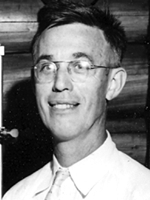
John Bartley Schmitt (deceased 14 July 1995) was elected as Fellow in 1943. A professor of entomology in the Department of Entomology and Economic Zoology at Rutgers, the State University of New Jersey for 40 years, he was an internationally recognized morphologist for his work on insect nerve topography. Dr. Schmitt was also well known for his dedication to teaching and the practical training materials he developed on structural, household, and stored product insects.
Born on 26 June 1909 in Trenton, NJ, he earned his B.S. (1932), M.S. (1933), and Ph.D. (1936) degrees at Rutgers, where the eminent morphologist Robert Evans Snodgrass guided his doctoral research. He conducted graduate studies for one year (1933–1934) at the University of Maryland before returning to Rutgers to complete his doctorate. His doctoral research was published as a monograph in 1938 under the title, The Feeding Mechanism of Adult Lepidoptera.
He was appointed to the College of Agriculture at Rutgers in 1937, joining the faculty of the Department of Entomology and Economic Zoology. He served as director of the graduate program, department scheduling officer, and curator of the entomology museum, a collection that housed more than 130,000 specimens under his care until he retired in 1976. He served as chair of the Committee of Educational Policies at Rutgers, as president and trustee of the New York Entomological Society, and as associate editor of the International Journal of Morphology and Physiology.
Schmitt was recognized for his teaching and instructed graduates, undergraduates, and non-degree students in nearly every entomology course in the graduate curriculum: insect morphology, insect embryology, insect metamorphosis and development, insect taxonomy, insect embryology and systematics, and general entomology. His systematics course included multiple trips to the Museum of Natural History in New York City to view fossil evidence of evolution.
Schmitt was renowned for his insect nervous system work and he and his colleague, George W. Barber, were the first in the U.S. to demonstrate housefly resistance to DDT. He was interested in Brood X of the periodical cicadas and published a paper in 1970 on their distribution in New Jersey. During World War II, he and his colleague, Thomas D. Mulhern, developed a sanitary entomology course for officer candidates’ training for the Sanitary Corps. Starting in 1944, he directed development of technical and practical training for the pest control industry.
In 1973, Dr. Schmitt was honored by the ESA Eastern Branch with the L. O. Howard Distinguished Achievement Award. In 1976, in recognition of "his outstanding services” the Cook (now the School of Environmental and Biological Sciences) Alumni Association presented Dr. Schmitt with the George Hammell Cook distinguished service award. The John B. Schmitt Award for an outstanding undergraduate in entomology was established by Rutgers’ Department of Entomology in 1977, in honor of Dr. Schmitt’s many contributions to the science of entomology and the education of undergraduate and graduate students.
